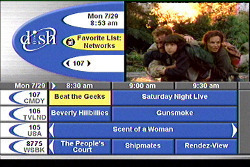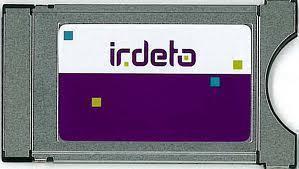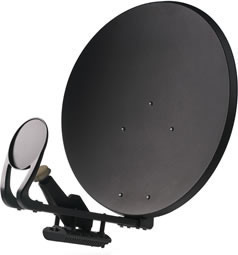LNB (Low Noise Block) is the receiving end of a satellite dish. The LNB must be pointing directly to the satellite overhead in orbit to receive the strongest and clearest signal. There are many types of satellite dishes available, some of them are installed in a fixed position, others are installed so that they can move regularly. The type of satellite that the user would like to receive signals from usually determines this. As with a normal TV antenna, it may be required for the user to adjust the LNB in order to receive the highest quality (strongest and clearest) satellite signals available.
Types of Satellite Dishes
The type of satellite signals to be received usually determines LNB adjustment. There are two distinct types of satellite dishes available, those that are installed to move (dynamic) from one satellite to another on a regular basis (depending on programming) and satellite dishes that are installed to be stationary. They do not move and receive all their programming from one source.
LNB Adjustments with Stationary Satellite Dishes (DBS)
Most satellite TV dishes today use a stationary position to receive all of their television programming. They are called Direct Broadcast Satellite (DBS) or sometimes referred to as direct to TV. These satellite dishes are usually part of a paid service. Two popular services in the United States are DirecTV and Echo Star’s Dish Network.
DBS satellites are installed to be stationary, they point in one direction to receive signals from the satellite that is in geostationary orbit in space. Geostationary orbit means that it is always in the same position in space due to the satellite’s same speed and earth’s rotation.
Most people only adjust their DBS satellite dishes once, usually when they first install it. However, if the signal is not clear or if the satellite dish has unexpectedly moved or needs to be removed and placed someplace new, the LNB will need adjustment.
Use an LNB Tester to Adjust the LNB
An LNB tester is helpful for finding and testing signals from the satellite that the user would like to align his/her dish to receive signals from. All LNB testers are very sensitive and usually include some sort of meter, either digital or analog, that clearly states the signal availability and its strength.
For most DBS systems, the frequencies vary from 950 MHz to 2050 MHz. Besides locating the signal’s availability, LNB testers usually tell the user at what strength the signal is (usually from -40 to -80 dBm). When installing a dish, which obviously includes the LNB, connect the LNB tester between the dish and receiver. As the user views, his/her LNB tester searches for the best response in satellite signal. Most dishes must first point to the Southern sky and must not be obstructed by trees, buildings, or other structures.
Now using the LNB tester, try to find the dish’s best position, incorporating the signal’s strength and availability. Most of the time, users will just need to slightly adjust a dish that has moved a little.
For instance, if a strong wind moves the dish slightly upwards or to the right or installation materials such as a hardware bracket has loosened and gently turned the dish’s direction, using the LNB tester is a sure fire way to regain a high quality signal. However if users do not have an LNB tester, they will have to ask a friend or family member to tell them which position is best for receiving a signal. This can be more time consuming and less scientific.
LNB Adjustments with Movable Satellite Dishes
Satellite dishes that move from one satellite to another depending on the program the user wants to watch are usually installed on rotators. These rotators are usually controlled via remote control and have electrical motors to move the dish in various directions. Most rotating dishes can change the height degree of their LNB and the direction that the LNB faces. While these rotating dishes cannot point in every direction, they are usually able to point in the most useful directions based upon which satellite program the viewer wishes to see most.
With a rotating LNB, users can easily control the direction with a remote control using digital coordinates. Years ago, users would have to manually move the LNB connected to the dish.




Nali Brandon
I have a huge problems in decordar the is bad sometimes and the in it are not good the when I try searching it,it doesn’t give me good channel and some channel even repeat it self’s and some channel came with sign of money like dis for example $fox sports 1 pls u guys need to help me i need sports channel and many
Rusell Owens
I have DirecTV and am on the fringe of reception. The installer has been here a couple of times and says that I have the best signal I can get with the equipment.
I loose some HD channels, such as CBS, Fox business channel and a few others at different times of day.
I have been told, second hand, that a BIGGER DISH will solve the problem. My installer is only familiar with standard equipment. Will, say a 1.8 meter dish work?
Can you help me??
My phone service is not very good so email is the best way to contact me. Rdo4evr@gmail.com
gifmunyaradzi
good day sir,im having a problem with my decoder,it is having a low signal strength